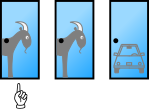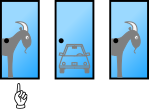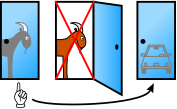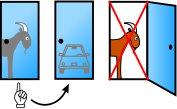User:Rick Block/MH solution
Solution[edit]
There are two main approaches to solving the Monty Hall problem. One is to compare a strategy of switching (always switching to whichever door the host doesn't open) with a strategy of staying. The other is to evaluate the conditional probability the car is behind door 2 given the player picks door 1 and the host opens door 3. Because the problem is symmetrical, these two approaches show (and must show) the same result - switching wins the car 2/3 of the time.
Most popular sources present solutions comparing a strategy of always switching with a strategy of always staying with the player's initial choice. For example, the solution presented by vos Savant in Parade (vos Savant 1990b) shows the three possible arrangements of one car and two goats behind three doors and the result of staying or switching after initially picking door 1 in each case:
| Door 1 | Door 2 | Door 3 | result if switching | result if staying |
|---|---|---|---|---|
| Car | Goat | Goat | Goat | Car |
| Goat | Car | Goat | Car | Goat |
| Goat | Goat | Car | Car | Goat |
A player who stays with the initial choice wins in only one out of three of these equally likely possibilities, while a player who switches wins in two out of three. Thus, a player who picks door 1 should switch to whichever of door 2 or door 3 the host doesn't open, and by doing so will win the car with probability 2/3.
The other main approach to solving the problem, used primarily in academic sources, is to treat it as a conditional probability problem. The probability the car is behind any one of the doors before the host opens a door is 1/3. The probability the car is behind Door 2 after the player picks Door 1 and the host opens Door 3 is the conditional probability the car is behind Door 2, usually written as:
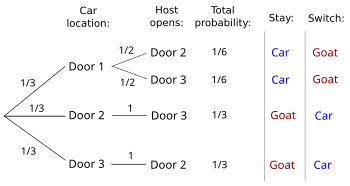
This conditional probability can be determined referring to the figure below, or to an equivalent decision tree as shown to the right (Chun 1991; Grinstead and Snell 2006:137-138). In each figure, it is assumed that the contestant initially chooses door 1. The probability can also be formally derived as in the mathematical formulation shown in the appendix.
If the player picks door 1, the car is behind door 2 and the host opens door 3 with joint probability 1/3. The car is behind door 1 and the host opens door 3 with joint probability 1/6. These are the only possibilities given the player picks door 1 and the host opens door 3. Therefore, the conditional probability the car is behind door 2 is (1/3)/(1/3 + 1/6), which is 2/3. (Morgan et al. 1991) The intuition behind this solution is that the host must always open Door 3 if the car is behind Door 2, but opens Door 3 only half the time the car is behind Door 1 - so a player who switches wins twice as often as a player who doesn't.


